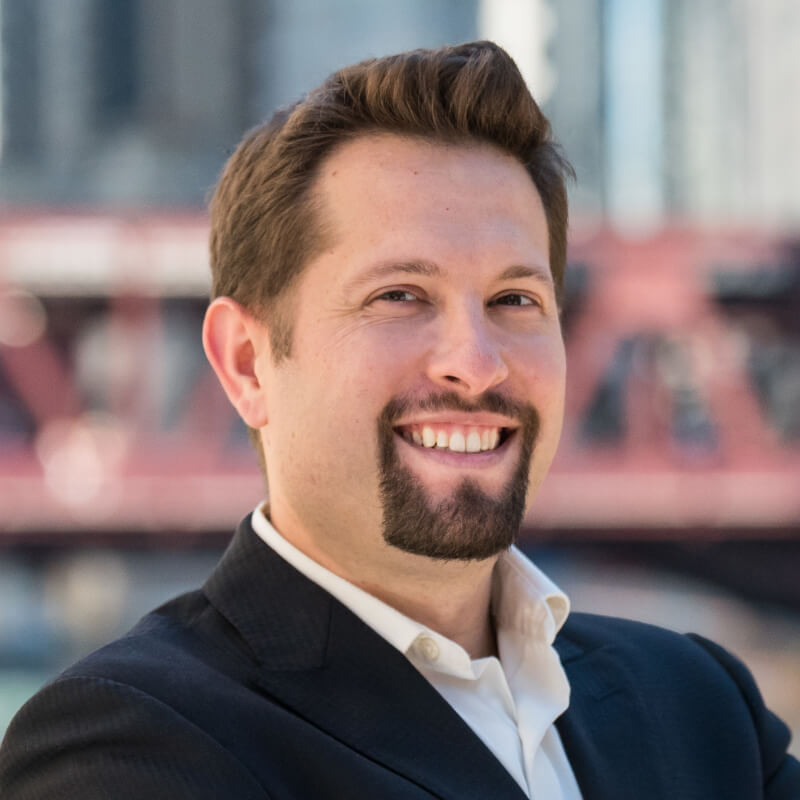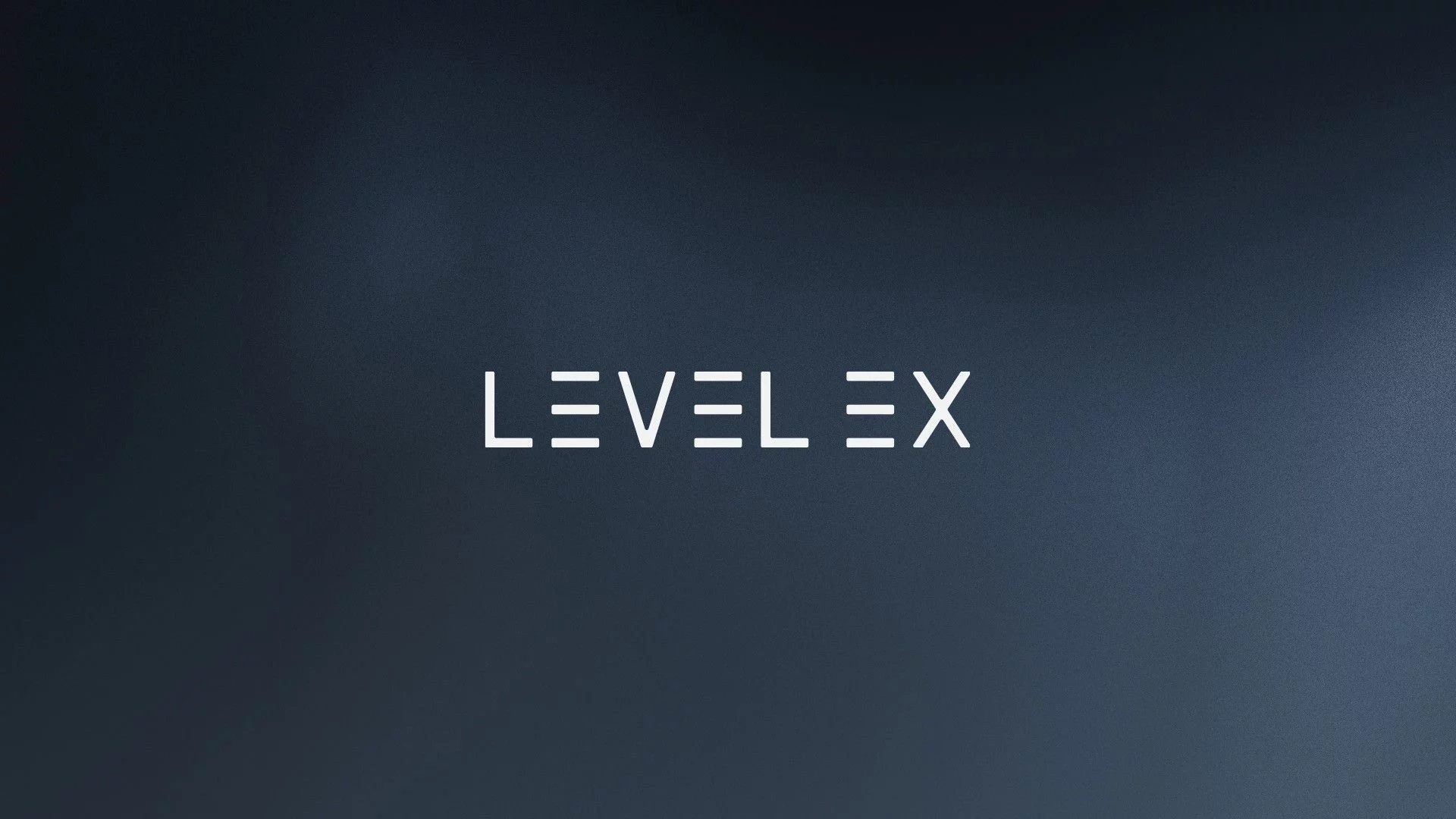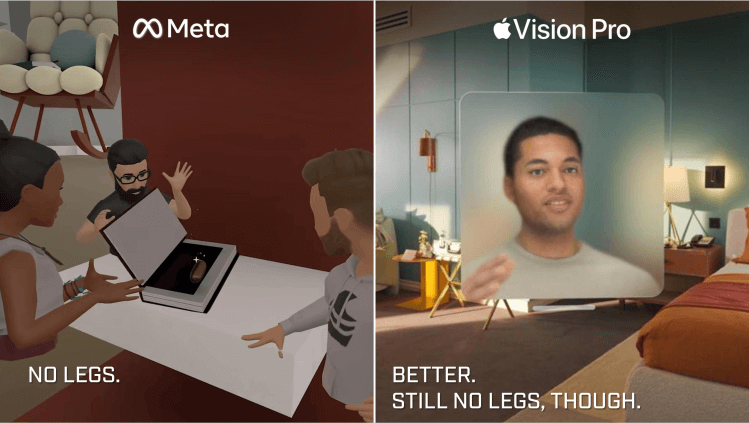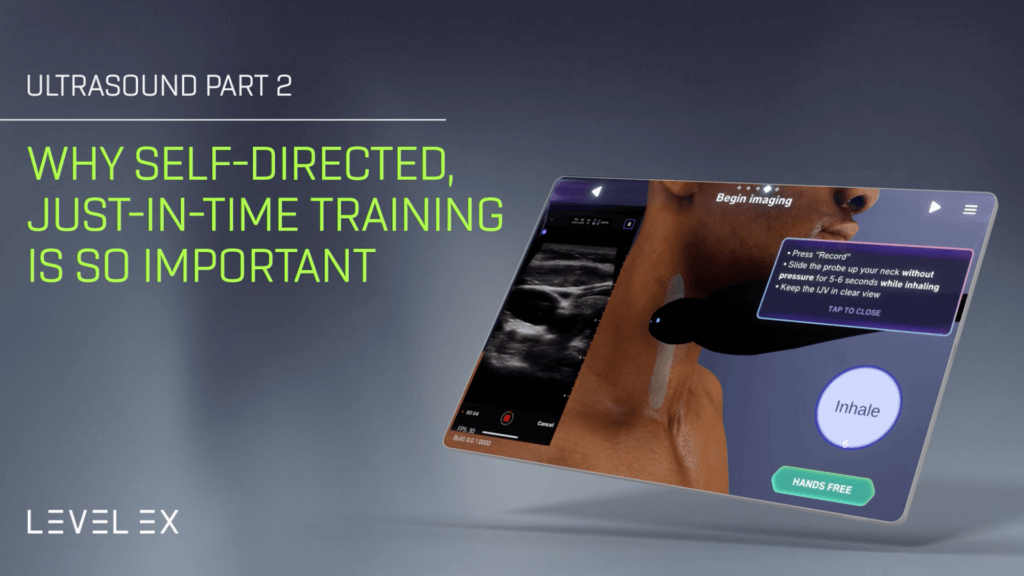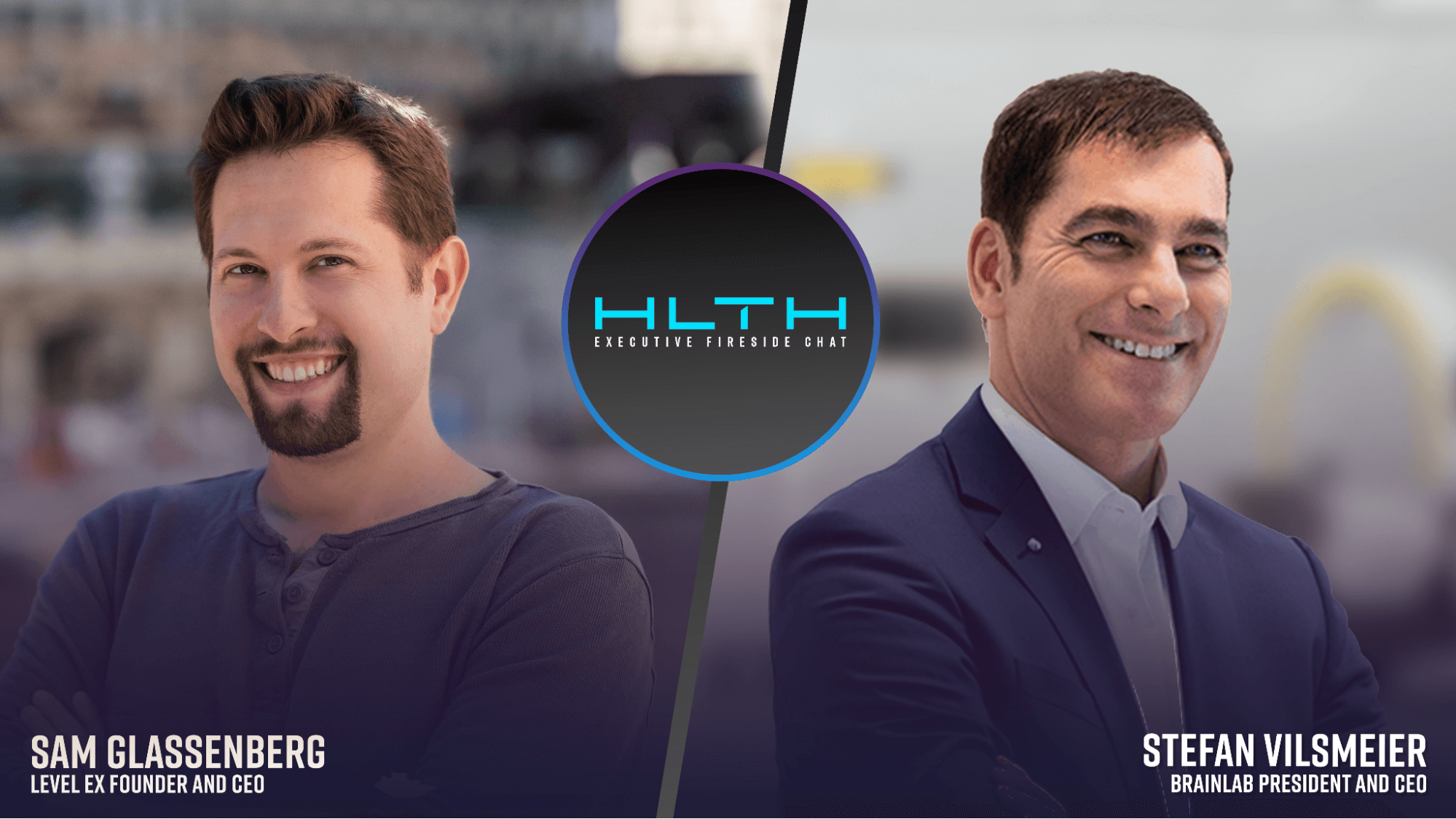
HLTH Themes: A Fireside Chat with Stefan Vilsmeier & Sam Glassenberg
With the volume of medical knowledge increasing exponentially and the continued proliferation of technically sophisticated procedures and products, digital transformation in healthcare is more important than ever before—especially when it comes to education and training. Stefan Vilsmeier, Brainlab president and CEO, and Sam Glassenberg, Level Ex founder and CEO, discuss the changing industry and the path forward in advance of this year’s HLTH conference.
“The theoretical possibilities in healthcare are basically tenfold greater than what is currently integrated in broad clinical practice. For that reason, we need to create a whole different level of proficiency that can be rolled out faster and more broadly.”
—Stefan Vilsmeier, Brainlab president and CEO
Watch the Full Discussion
Panelists
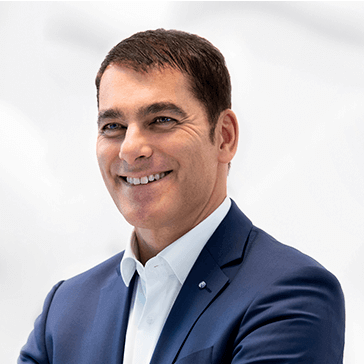
Read the Transcript Below
Sam Glassenberg: [00:00] Hello. My name is Sam Glassenberg, founder and CEO of Level Ex. I’m here with entrepreneur, bestselling author and Brainlab president and CEO, Stefan Vilsmeier. Brainlab creates software-driven medtech, digitizing, automating, and optimizing clinical workflows. Founded back in 1989 and headquartered in Munich, where Stefan’s dialing in from now, Brainlab serves physicians, medical professionals, and patients in over 5,800 hospitals across 117 countries worldwide. Brainlab revolutionized digital medical technology back when they introduced software for radiosurgery and for surgical navigation. Today, Brainlab leads the industry in innovation with surgical navigation, precision radiotherapy, and digital operating room integration. And as of last year, Brainlab is the parent company of Level Ex.
Stefan Vilsmeier: [01:00] I imagine there were industry participants who asked themselves what a company like Brainlab would want to do with a company that makes games for doctors. For us, our ambition was always to digitize surgery.
When you think about digitizing surgery, on the one hand, you need to track surgical instruments and understand their correlation and interaction with tissue. You need perfect models, almost like a digital copy or twin of the patient, to create a link between the digital and the physical world. The element that Level Ex adds to that is the digital copy of the surgical workflow.
While every surgeon is used to practicing in the physical world, now there’s a virtual way to go through exactly the same workflow in the same learning and thought patterns. Therefore, it’s basically the digital copy of the real world when it comes to the procedure, learning, and medical practice. Then, of course, getting that synchronized with the physical world is what we really do.
For us, it was a very important strategic move, but it also gives access to adequate and accelerated learning in a number of different areas. As a technology company, the challenge is always figuring out how when we introduce a new technology, we can get it deployed quicker. So it’s really frustrating for me when we’ve got the coolest new technology, but it takes a while to get from the first doctors to the next level and to get the really broad market to adopt it. Essentially, Level Ex allows us to accelerate that process.
Sam Glassenberg: [03:07] Right. And this is a perfect segue into a number of the themes that we’re going to talk about today. We’ve talked about access, and you also mentioned adoption. This is a problem that we see not only in surgery, but across the healthcare ecosystem. The volume of medical knowledge is growing exponentially, and as everything from pharmaceutical treatments to surgical procedures becomes more complex and more technically sophisticated, the barrier to adoption can often become higher because you need to actually train on how to use these things. This takes time, and the technologies for training haven’t necessarily improved at the same rate as the technologies for genomics and pharmaceuticals and radiosurgery.
This discussion is themed around the HLTH conference, which takes place once a year. It’s focused on digital innovation in healthcare—the idea behind HLTH is that they bring thought leaders together from all facets of the industry to create a dialogue around digital transformation in healthcare. At HLTH, the people who are actually presenting are leaders and decision makers. It’s people who are moving the industry forward and people that you and I know. In addition to great talks, it makes for effective and efficient networking. In advance of the conference, they’ve actually published a few themes that they’re going to be exploring this year. So this is a bit of a sneak preview.
Theme one is called health’s tech-tonic shift. As healthcare delivery trends toward a more digital, patient-first approach, and the number of health applications continues to rise, how can we ensure that the tech we are integrating into our lives is actually making a positive difference?
So Stefan, what do you think about that? We see so much technology for technology’s sake. At Brainlab, how do you make sure that the technology that you’re creating is creating the most value for medical professionals and patients?
Stefan Vilsmeier: [05:50] It’s all a matter of training, and it goes back to when I installed the first OR systems 30 years ago at a small hospital in China. The neurosurgeon was 23 years old and had just finished medical school two weeks before I got there. I ended up having to put on the head frame, and for me, it was clear that training was really a key component in driving our technology forward. So as a small company at that time, we invested very heavily in training and education, and that became a key element.
Even in neurosurgery, where you need to find a tumor using a digital model, in 70% of cases people don’t want to go through the process of outlining the tumor. They say, “I’ll just aim, and eventually on the screen I’ll see when the tumor pops up.” I think that the theoretical possibilities in healthcare are tenfold greater than what is currently implemented in broad clinical practice. And for that reason, I think we need to add a whole different level of proficiency that can be rolled out faster and more broadly than today’s technologies.
Also, best practice guidelines and insights as to how technology is being used are changing all the time. So, even the speed at which we need to adopt a best practice or guideline and roll something out is completely shifting. For example, during the COVID crisis, the way doctors learned to intubate a patient really changed, and that’s probably something you can really talk to, Sam.
Sam Glassenberg: [07:38] Exactly. We’ve seen over the last year that there’s been a digital transformation in terms of how doctors learn, but, in many cases, it hasn’t been for the better. We’ve gone from being able to train doctors in person in groups, or potentially in the operating room, and now with COVID, a lot of that has shifted to Zoom. We’ve gone from being able to manipulate a mannequin together, or touch it, or manipulate a device together, and now we’re trying to demonstrate something using PowerPoint slides over Zoom.
In that sense, we’ve seen that digital transformation can have a negative effect. But one of the things that Level Ex has been working on, and that we’ve been employing across the industry—Brainlab has been using it, for example—is our cloud gaming platform Remote Play™ . With Remote Play™ , a surgeon and a trainer, or multiple surgeons, can get together over Zoom or Microsoft Teams or WebEx and can actually interact with a virtual patient that’s simulated in the cloud. So now what happens is that a Zoom or Teams remote learning experience is actually better, because now instead of being limited to a mannequin or a cadaver or the particular case that’s presented on the table, we can jump to a certain step in the procedure, we can rotate the angle so we can see it from the right view, and we can actually go to the particular patient scenario that matches, epitomizes, or represents the educational gap that we’re trying to close in this particular discussion.
Stefan Vilsmeier: [9:12] The main part of that is that we are now adding an interactive component to it.
Sam Glassenberg: [9:19] Yes.
Stefan Vilsmeier: [9:20] The least effective way of learning something new is lectures. And the whole world has gone to that method over the last 18 months. This is a pivot from being able to try things out, which is the most effective way of learning, almost like being in a sandbox and trying something yourself. It doesn’t matter what you learn, from little children when they take their first steps to how our ancestors learned to throw a spear. All of that is basically driven by trying things out, and with the pandemic, we’ve gone again to lecture mode, which is a lot harder but also a lot less efficient. Reading, in fact, is more effective than just being lectured at. But again, the most effective way is trying things out.
Providing a digital way of trying things out yourself, where you have your sandbox in which you can run different scenarios, different variations, and try different decisions, is really the difference. Without that, I don’t think we will be able to provide the adequate healthcare that the world needs, because we have, in most of the Western world, an aging population and patients are demanding better and better healthcare. Without digital transformation and artificial intelligence (AI), we won’t be able to meet those expectations.
But how do we make sure that we don’t leave people behind? For a successful digital transformation, I think we need three things. We need technology, we need access to data, and we need to change something in people’s mindset and readiness. Level Ex and the opportunity to use games for accelerated learning is the best thing I’ve seen in 30 years for making an impact. And making an impact not only for people that live in the Western world, where they could easily jump in a car and drive to a training center or attend some of the best medical schools, but as something that democratizes access to adequate healthcare. Everyone nowadays has a mobile device that essentially gives them access to that type of training and education, so it is something that unites us.
It helps with more quickly rolling out best practices, et cetera, but it can also be customized to different parts of the world and their access to technology, and those parts I think are very exciting prospects that I believe will make technology useful for physicians and their patients.
Sam Glassenberg: [12:18] Dare we say, the best way to learn something is to play with it?
Stefan Vilsmeier: [12:24] Yes.
Sam Glassenberg: [12:25] That is the best way to explore a topic and develop the mental model with the most rigor. Moving from lectures on one side, to reading, to watching, to actually interacting with something. What you’ve been describing actually aligns really well with theme #3 of the HLTH conference, which is health for the greater good. At HLTH 2020, Lloyd Dean said, “Healthcare is a right, not a luxury.” In our current health system, especially here in the United States, we struggle with uninsured, under-cared for, underrepresented, underwhelmed individuals. How can we close the care gaps made worse by the pandemic and remove the social and economic barriers to accessing the best care possible?
And I would extend that Stefan, in your context, to the world at whole, right? What insights do you have from a global perspective on how we can increase democratization and increase access to care?
Stefan Vilsmeier: [13:22] When I started building my company 30 years ago, what really caught my mind was the idea of software being something that you can scale and replicate in a way that we couldn’t have imagined 30, 40 years ago. Now, mobile devices and other technologies, like cloud computing, are taking that to an entirely different level. Having started a company, what I always wanted to do from day one was have an impact with what I do, and I always found healthcare to be exactly that area.
Having grown up in Europe, we have the mindset where education and many other things are free, and the expectation to give back to society is also different. What really drives employees today is not necessarily just maximizing their income, but also working for a company that is engaged in projects. We provided technology in countries that otherwise couldn’t afford it a long time ago. Now, all of the sudden, something like Level Ex is the technology that really will virtualize education. I think that the next step is also to virtualize those expansive navigation systems, and mixed reality and Magic Leap is a way of doing that. Instead of a $250,000 hardware device that you need to wheel into the operating room, you’ll be able to put on a $5,000 headset and you will be able to see the patient with X-ray eyes and immediately capture anatomical problems, trauma, et cetera. Finally, we will also find cheaper ways of turning operating rooms digital. So instead of being something that only the first world is able to afford, I think that digital technology is about to shift gears.
The way cell phone technology has allowed some of the merchant countries to leap frog what is implemented in the first world—you find better cell phone coverage throughout most parts of India than you find in Manhattan—is another reason why I think there’s hope for better access in those countries. It starts with training, so Level Ex in my opinion is really a critical component of that. But also, the technology is more accessible and so is the data.
We need to build a more powerful system that’s based on sharing information and data. I think that a lot of the business models in healthcare are built around selling a disposable that may cost $5 to make for $1,000 and building a complex hardware infrastructure around that. So software is not used for what it is meant to be used for, like this universal, intro-optical, scalable concept, but something that is used as a proprietary system to maximize lock-in effects of certain hardware.
I think those business models will be a thing of the past, and I think patients should really demand increased access to adequate healthcare. We as a company want to do everything to really facilitate that by also coming up with more flexible and software driven business models and concepts. That will definitely be data-driven. The question of where technology development will take place in five or 10 years from now is also going to be dependent on data. I think that there are certainly emerging markets that can lead the way regarding how they capture their data, how they make the data accessible, and how they become an interesting place for developing the next generation of healthcare technology.
Those developments will also be driven by AI and software developers. I find entrepreneurship in a number of places around the world that you wouldn’t really expect, and the ability to shape healthcare through AI and other technologies is no longer a privilege of Europe, the US, and Japan. It’s a number of other markets like Malaysia and China that are still developing, that all of the sudden are coming up with lots of innovation and a fresh new mindset. Not being entrenched in those structural contingencies that result in a gridlocked system is sometimes an opportunity to even out-innovate the Western world.
Sam Glassenberg: [19:03] I think that the point that you made, getting back to AR headsets, was actually intriguing, because we think about the opportunity and potential of AR, right? We think about having a Magic Leap headset and the benefit for the surgeon and the patient of being able to project the MRI or the CT scan or the ultrasound view on top of the patient that you’re looking at, so you don’t have to register in your brain what you see on the screen. And then from there, we can look at the educational benefits. Now we can take that same headset and project a virtual patient over here and practice doing the procedure beforehand.
The point that you made is really interesting, because as we do this, we’re actually democratizing access to the broader suite of technologies. With an AR headset, instead of needing a million dollars of equipment and screens and all the complexity, you put it on, you push a button, and you can create a virtual endoscopy suite, cath lab, or OR. The screens are all placed correctly, and you have all the tools you need and all the visualizations, and you could also project the training material on top of it.
What this would do is not just improve the situation in developed countries, but lower the barrier to entry for developing countries to be able to build out this infrastructure because so much of it exists in software. And really, what’s enabling that is a headset that costs a few thousand dollars and the software on top of it. So I think that’s an interesting way to think about it.
Stefan Vilsmeier: [20:36] And you would be able to press a button, and at the push of a button, you could get an expert to be available online in a different corner of the world, who may be a teacher for a new procedure or a new concept. Maybe helping you take care of a very rare case or special situation—it could be a clinical support group, or it could also be technical support. This is something that will be important for rural areas in the developed world, but also something that really is equally applicable anywhere.
It may also involve several different services—maybe reading CT scans for a radiology report could be done equally well but less expensively by other countries, and so I think that there’s also going to be a different level of competition for services and quality around the world. That quality needs to be measured and characterized, which I think takes us to another important topic, which is how we can create a data ecosystem that really would be patient-centric and patient-determined, where patients are basically in charge of their own destiny. Where it’s not a matter of big platform companies having everything from life insurance to an activity tracker coupled with your health insurance and a drone that then delivers your 3D printed track.
It’s a great new world, but I don’t think, for me as a patient, that that would meet my own values in terms of privacy. For that reason, I think we need to put a patient in the center and give the patient control over their own data in a very privacy-preserving and secure way. This is, in fact, where we believe that being a European company is of tremendous value, because Europe—and Germany in particular—has the highest interpretation of the European General Data Protection Regulation (GDPR) laws. Brainlab has picked the toughest market as a home for developing a data-driven system.
However, I think we’ve started to really look at how we can build a data ecosystem that would also need broad, societal consensus. It’s becoming pretty clear that it wouldn’t fly if we were more or less taking over the toll both and controlling access to data. We need to do that in a very liberal and broad way, which still makes it open and accessible to others as long as something is covered by the patient consent. Then we are more or less just a contractually committed execution entity of the patient’s will, so to speak.
We also think that patient consent should be standardized, and it should be given once and then applicable to all the data. And if we are more or less helping to consolidate the data, we should be privileged in our access to the data over other users. Whether patients want to really improve healthcare through their clinical resources or through science and fundamental research, that research should be at the patient’s discretion.
In Europe, we have this mindset that sometimes, “Oh, it should be just research.” But a scientific paper can never really provide products that serve a broad majority of patients. For that reason, it’s important that there’s really a broader discussion, and also trusted infrastructure that enables it.
A lot of times, people think that if we just made all data available, things would be great. But even if you had it over the hard-disks of all the hospitals in, let’s say, the U.S. or Germany, it’s just garbage that you wouldn’t be able to process in a meaningful way (with a few exceptions). If you were to actually structure the data in a more careful way, you could capture it at the point of care in a structured way and not just as text that somebody typed in that is really difficult to make sense of, because of a lot of biases and the way the data has been processed. Innovation needs to be encouraged, and the entire data value chain is what we’re focusing on recently.
We’re looking at doing that across a number of clinical subspecialties and also doing that in different countries. With registries worldwide, nothing scales—these are two- or three- person companies each, and they hardly scale on a national level and certainly not on an international level. Today in a data ecosystem, you should have structured radiology reports and patient-reported outcome measures and images that can be processed with AI, along with special clinical data and everything that’s coming from information systems. To bring all that together in a trusted way is tough, so we’re doing something that hopefully will work in Germany. And if it works in Germany and Europe, what works in Europe is also something that can be adopted globally considering that even some states in the US, such as California, are adopting several concepts from the GDPR.
There is an ongoing debate about the power that Amazon should really have. I think it’s a wonderful company that we use as well, but I think that using it, or Microsoft, in basic cloud computing is the role those companies should play. I’m not sure that they should also be providing consumer services that are for building customer profiles with mapping services and tracking and speech control, et cetera. And also, on the other hand, be processing our most private data—they should be doing one of the two. So for that reason, we’re trying to build an ecosystem that will have to do with providing better healthcare to a broad area of the world.
Today at Brainlab, we’re hosting a craniomaxillofacial symposium. It’s probably one of the most technically sophisticated subspecialties, but also one of the smallest surgical subspecialties. Unless you really pool all the data globally, you’re unlikely to collect enough data to further the practice. It’s also a subspecialty where almost every single patient is custom, all the way to even custom implants. Therefore, collecting data and finding better ways for training, because the cases are so rare, is essential. It’s an exciting moment where Brainlab together with Level Ex can really shape the future of digital health.
Sam Glassenberg: [28:09] One of the interesting areas that you started touching on was Brainlab’s work in standardizing and structuring data, and creating standardized registries so that data can be more broadly available and be used for all of these broad beneficial purposes, but obviously while respecting the privacy of the individual patient. Theme two is life sciences game-changers. You had alluded to some of the disciplines and specialties that you’re working in. So the theme is basically that—throughout 2021, there have been incredible advancements in fields such as genomics and oncology, and these are catapulting us into a new era of science. How is this changing the game?
And you started to talk about these registries. Can you talk a little bit about what Brainlab is doing specifically around oncology to help accelerate the development of new treatments?
Stefan Vilsmeier: [29:10] We’re seeing a couple of important trends. First of all, there’s always a distinction between what is a clinical study and what is routine care. They are two distinct areas, but I think the distinction will go away, and it’s really crucial and an important step that that all becomes one and that every patient will get the data collected and processed at the same level as if it were a clinical study.
That will also move us from doing only prospective clinical trials to retrospective and continuous analysis of what people call real-world data, including basic patient reported outcome measures and continuous data that may be collected from activity trackers and the like. So that can build a more complete understanding of how patients are doing.
For an oncology patient, for example, it all starts with how you even capture the diagnosis in the first place, which is of course for many patients devastating news. If you’re diagnosed with cancer, basically you’re getting, more or less, a written report. Most clinical oncologists look at a report and then from there drive their decisions.
But there are two things, too, that I think are important. One is that all those patients are followed, and you’re developing a number of longitudinal data so that the radiology report is not generated by copying and pasting, but is generated from the same tools that are able to quantify any subtle change in the tumor volume using, maybe in the background, 50 radiometrics that analyze subtle changes in tissue and composition and patterns of the tumor. Then you get a lot of valuable data that allows you to quantify the change in tissue.
This way, for every cancerous disease, you get much more detailed and valuable data so you’ll be able to recognize a change in the body’s reaction to a drug, et cetera, much earlier. You might be able to develop much better predictors as to whether therapy is working. The same thing would also be applicable to degenerative diseases where you can detect patterns much earlier.
Starting with a structured radiology report is an important part, but then also, most patients are not just treated with a clinical oncology approach. Twenty years ago, I remember the discussion was that the decoding of the human genome was going to be the silver bullet that would cure every type of cancer. While a lot of progress has been made and several types of cancer have turned into chronic diseases, it makes it more important to follow the subtle changes in the composition of, or the change in size and shape of, the tumor. Most patients also end up getting a number of different treatments, from surgery to radiotherapy, to immunotherapies, et cetera.
If you’re trying to determine whether a particular track was successful or how it impacted the patient’s journey, every patient is different, so we must capture the entire journey. We need to collect the data along the way in a structured format and compose it in registries so we can better personalize treatments.
The data we collect from patients today is setting the standard for cancer treatments in our children and grandchildren. Therefore, not collecting data is basically killing patients at scale. I think it’s a moral obligation today, for all of us, to contribute with our own data to the future of healthcare. It’s even more dramatic and even more important—and it’s already pretty important to be donating your organs—but I think it’s even more critical to do that with data because the data isn’t gone; it’s still yours, and you can still use it—you just have to share it with others. Not sharing data, I think, is really a problem. Therefore, creating the ecosystem that allows you to do that in a systematic way is important.
I see more and more pharmaceutical companies starting to insource some of their clinical research, for instance. Providing better data is important for that reason, but it’s also important for hospitals. Hospitals today have information systems that are, more or less, collecting data from billing, and you can probably still search them, but it almost stops there. They don’t capture the whole wealth of clinical data. On top of that, you need to have a layer for clinical searching, but also for research and studies. When it comes to personalizing each patient’s treatment, you need to be able to capture the clinical information with a whole different level of granularity.
Since it’s difficult for many players to engage in that area, we have also created a spin-off called Snke OS, which embodies the idea of providing access to the fundamental software tools for taking the data, aggregating it, and putting that all in a cloud repository. If every company needs to do that from scratch, it doesn’t scale, it’s hard to share, and it’s hard to ensure that it’s interoperable—and there may be a lot of medical device companies that have innovative solutions that are dependent on better access to data.
For example, to optimize the parameters or setting of a treatment, we’re working very closely with Boston Scientific for deep-brain simulations of Parkinson’s treatment. We are helping with the data that’s being collected for the individual adjustments of the patient’s brain pace-maker, so to speak. Even the settings for that can be really fine-tuned around the specific requirements for each patient, and that is dependent on data. It’s dependent on data from healthy patients as well as patients that suffer from exactly that disease. I believe that we are at the beginning of a very exciting journey, and as bad as it is to be diagnosed with a life-threatening disease, there’s never been a better time than today, or a more encouraging time, to be provided with the best treatment. There isn’t anything that would deserve the name good old times, I don’t think.
Sam Glassenberg: [36:35] Right. You make an intriguing point here about the degree to which the technologies that you’ve developed for acute challenges in surgical oncology are now proving to be incredibly relevant and helpful in medical oncology. It’s not like one is superseding the other—quite the opposite. The technologies that you’ve been developing at Brainlab in order to identify tumors, to size them, to understand their position, and to be able to take that data and present it in a structured way are highly relevant to be able to measure the outcomes of either clinical studies or ongoing patient treatment with clinical treatment. That’s very exciting and probably not something that most are aware of.
Stefan Vilsmeier: [37:23] I think that we bring all the different elements together, considering that Brainlab has been in the business for 30 years. Thirty years ago, you were not a good neurosurgeon if you needed certain software. Today, you’re not a good neurosurgeon if you do most of your procedures without the proper software. Fortunately, times have changed, and I think the technology will end up with a lot of investment—potentially about $700 million cumulatively.
Therefore, a lot of core technology has been put together that we’re now going to be able to utilize. There are going to be a number of startups for those bigger companies that have an ecosystem in place and just need a way to anonymize the patient data. Or, if you want to develop a Magic Leap application, you don’t really have to start from scratch on the patient model, and you can answer questions like, “how do you do the tracking, where do you transfer the data, how we can securely have a cloud, and how do you build a 3D model from the 2D data?” That’s something that everybody would otherwise have to do from scratch.
All of a sudden, you’ll put on the headset, and everything will be taken care of so that in the future, with two or three software engineers, you can develop in 18 months a clinical application that otherwise you probably would have needed to hire 100 people to develop. That’s the idea, making advanced technology accessible in a much broader way. Again, it’s the access to data and the access to training to make sure that people get the best out of the technology and are fully able to utilize the technology, which we will do through Level Ex.
Sam Glassenberg: [39:11] And through democratizing the technology and democratizing the data, it’s not just increasing access to care for patients or increasing access to technology for the healthcare providers, but what you’re describing is also increasing access and democratizing healthcare innovation itself. The barrier to entry to innovate in healthcare, if you’re a new healthcare startup, is now much lower because you don’t have to develop your own registration, you don’t need to develop your own tracking system, you don’t need to develop your own tumor measurement system—you can use the state of the art and then build on top of that, and as such, it’s just another layer in accelerating the creation and adoption curve of new technologies in the healthcare ecosystem.
Sam Glassenberg: [39:57] We just covered a broad range of topics—a lot of food for thought here. Stefan, thank you so much for sitting down with me today to share thoughts and chat about these topics. We’ve definitely got to find an excuse to do this again soon. To our viewers, thanks again for tuning in. For those that are going to be participating in the HLTH conference, Level Ex would love to continue the conversation with you during the event. Please reach out if you’d be interested in meeting with us. As always, for more information or to request a demo of any cool Level Ex technologies, please visit us at www.levelex.com. For more information about Brainlab, please visit www.brainlab.com. Thank you.
